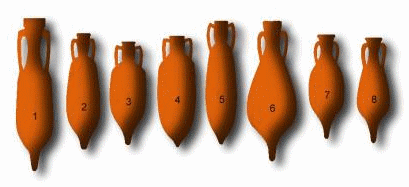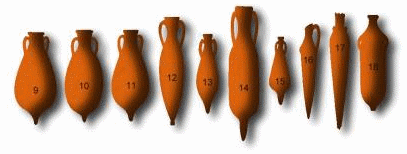

Educational Resources on the Ancient Mediterranean World




 |
 Educational Resources on the Ancient Mediterranean World |
 |

 
|
Amphoras
|
Amphoras (or amphorae) were used during centuries to transport liquids in all the Mediterranean area. They are the typical symbol of ancient sunken wreck. Their form varies according to the century, their origin and their use. Scientists tried very soon to catalogue them : the chart below on the left shows the description drawn by Heinrich Dressel for the Corpus Inscriptionum Latinarum published in Berlin in 1899. It describes the main types and their period of use. Their shape may seem strange at the first look, since they cannot stand upright, but it’s however very convenient to stack them up in a boat and to be carried by man. A clever point is that the weight of some amphoras, when empty, is equal to that of their content (it should thus not exceed 23-24 kg!) thus, when a boat has to be loaded, one will know that one full amphora will be balanced by two empty ones… On this field, the collector will undoubtedly be disappointed: these objects are extremely rare and expensive on the market. Diving to find some is theoretically quite easy… but don’t even think of it : this is most strictly forbidden! | |





|
Dressel’classification(*) The chart relates mainly to Roman amphoras.At the time it was set up, relatively few amphoras were known and could be dated. Later on, lot of them were found on the sea bottom. Dressel’s table however is the reference and the base of all later studies on the amphoras used for the transport of food stuff, and in particular for the classifications supplemented for example by Nino Lamboglia and Ricardo Pascual. Heinrich Dressel’s original description:
* Heinrich Dressel (1845 - 1920), Professor at the archaeological institute of Rome, in 1898 Director of the ancient numismatic collection cabinet of Berlin.  Download here our whole catalogue on Mediterranean amphoras (50 pages) in pdf format. Download here our whole catalogue on Mediterranean amphoras (50 pages) in pdf format.
|